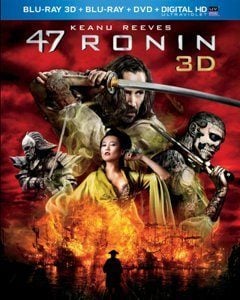- Joined
- May 9, 2003
- Messages
- 3,103
47 Ronin masters its samurai onto 3D Blu-ray with an edition that provides solid picture and sound for an intermittently entertaining movie. The film is a loose adaptation of the traditional Japanese story, retooled to bring in Keanu Reeves as a half-breed addition to the clan, and enhanced with some fantasy elements. The result is a beautifully shot spectacle that sadly falls short on the basics of writing and directing. Some of the supporting cast are excellent – particularly Hiroyuki Sanada and Rinko Kikuchi. The 3D version, converted in post-production, provides a surprising amount of pop-out effects and several scenes of deep dimensionality. As a hybrid of Western and Eastern storytelling, and as a hybrid of 2D and 3D design, this is a fascinating exercise. It’s a shame that the underlying movie isn’t stronger.

Studio: Universal
Distributed By: N/A
Video Resolution and Encode: 1080P/AVC, 1080P/MVC
Aspect Ratio: 2.40:1
Audio: English 5.1 DTS-HDMA, English DVS 2.0, Spanish 5.1 DTS, French 5.1 DTS
Subtitles: English SDH, Spanish, French
Rating: PG-13
Run Time: 1 Hr. 59 Min.
Package Includes: Blu-ray, 3D Blu-ray, DVD, Digital Copy
Disc Type: BD50 (dual layer)
Region: ABC
Release Date: 04/01/2014
MSRP: $49.98
The Production Rating: 2.5/5
Video Rating: 4.5/5 3D Rating: 4/5
Audio Rating: 5/5
Special Features Rating: 2/5
Overall Rating: 2.5/5
Reviewed By: Kevin EK
Support HTF when you buy this title:





